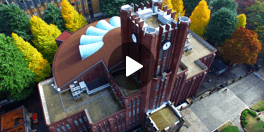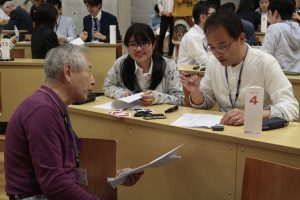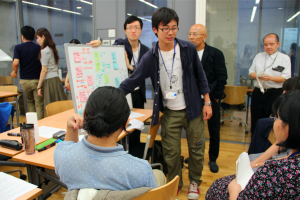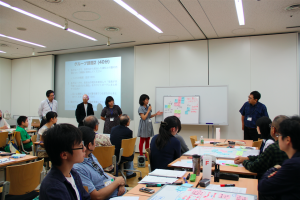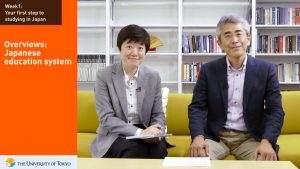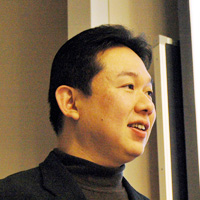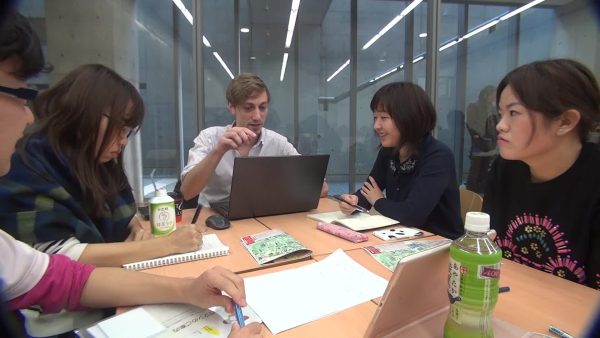
December 2, 2016
学環とMOOC(2)MOOCs and the III: Part 2
情報学環のMOOCの取り組みについて、今回は、いま山内教授が中心となって研究を進めている「反転学習」について取り上げたいと思います。
反転学習(Flipped Learning)とは
反転学習は、MOOCなどのオンライン映像で事前に学習した後、教室で教員や学生同士が議論しながら、応用的な課題を解決していくという学習のスタイルです。
従来の授業では、教師が教室で一斉に基本を教え、その応用については学習者が一人で行うことが慣習となっていました。けれども「反転学習」では、この形式を反転し、従来教室で行っていた知識の習得をオンラインで事前に学習し、応用を教室でディスカッションできるようになります。こうすることで、トータルの学習時間が変わらないままに高度な議論が可能となるうえ、知識習得が映像視聴となることで、むしろ学習者の負担は下がることが期待されています(詳しくは、反転学習社会連携講座:FLITで紹介されていますので、参考にしてみてください)。
2014年、「Visualizing Postwar Tokyo」の反転学習が、学部と大学院の二つの水準に分けて設計されました。大学院学際情報学府の授業では、NHK放送文化研究所と共同して、NHKのアーカイブ映像を用いた反転学習が行われました。筆者の一人(潘)は受講生として参加しましたが、この反転学習によって知識や意見を仲間と共有でき、戦後東京について理解が深まったのを覚えています。
また、情報学環にも縁が深い史料編纂所の本郷和人教授の『日本の中世の自由と平等』というコースでも、反転学習が試みられています(日本語MOOCであるgaccoで提供。2014年~)。この反転学習では、老若男女問わず参加者が議論しあうことで、単に映像を見たときよりも、高次思考課題の成績があがったという興味深い研究結果が出ています。
山内教授によれば、MOOCは知識をアップデートするには良いツールですが、これだけでは高度な人材育成をするのに十分ではないと言います。「MOOCのようなオンライン学習と対面学習をどう組み合わせていくかが、これからの重要課題になってきます」。MOOC事業はいま、映像をベースにしながら、高度な対面学習との組み合わせを研究する段階へと進んでいるのです。
東大のMOOCのこれから
最後に、東京大学のMOOC事業の未来について、お話をうかがいました。いま、MOOCはめまぐるしく変化し続けています。それゆえに、機械的にコースを提供しつづければよいというものではなくなってきました。そのためには新しい時代に適応する、機動的な研究開発が必要になります。「MOOCという形に固執するのではなく、未来の学習環境へ挑戦していくことが大切です。これこそが、情報学環が担う役割だと思います」。
2016年4月、「情報学環メディアスタジオ」が竣工しました。このスタジオは、東京大学における初めての本格的な映像配信の施設です。メディアスタジオが出来たことで、より高水準の講座が提供できるようになったともいえるでしょう。
新しいMOOC講座は、主にこのメディアスタジオで収録されています。たとえば、その中の一つ、Studying at Japanese Universitiesは、日本への留学を志望する海外の学生向けに制作されたコースです。日本に来て何ができるか、日本に留学するためにはどうすればよいのかを、東大から世界に発信しています。
これからMOOCや反転学習によって、未来の大学のあり方は変わっていくでしょう。しかし、教員と学生、学生同士のネットワークを作る「場」としての大学がなくなるわけではありません。技術の進化とともに、学習のスタイルが変化しつづけるなかで、情報学環の取り組みはますます重要になっています。
記事:潘夢斐(博士課程)・松山秀明(特任助教)
取材:潘夢斐、岡田美保(学環長秘書)、松山秀明
This article describes how research on “flipped learning” is being pursued at the III under the leadership of Prof. Yamauchi.
What is “Flipped Learning”
In the past, it was established practice for course instructors to teach the fundamentals in the classroom and have students apply these fundamentals in their individual work. In flipped learning, however, this practice is reversed. The knowledge previously learned in the classroom is now acquired online beforehand, and discussions about application can now be conducted in the classroom. This not only makes it possible to advance the level of discussion without altering the total time investment, but also holds the promise of reducing the burden on learners by allowing knowledge to be acquired through watching video content. (For further details, please refer to the webpage of the Department of Flipped Learning Technologies [FLIT].)
Flipped learning in the course “Visualizing Postwar Tokyo” (taught in 2014) was divided into two parts suited to the levels of undergraduate and graduate students respectively. In the graduate school classes, the flipped learning program was conducted in cooperation with the NHK Broadcasting Culture Research Institute using visual material from NHK Archives. One of the authors of this article (Pan) was a student in these classes and recalls that the sharing of knowledge and opinions through flipped learning allowed participants to deepen their understanding of postwar Tokyo.
At the University of Tokyo Historiographical Institute (with which the III has close ties), flipped learning has also been implemented in a course on “Freedom and Equality in Medieval Japan” (distributed by the Japanese MOOC provider Gacco since 2014). Rather than simply providing lecture content to students, this course has given rise to some very valuable and interesting new research insights as a result of intense discussion among its diverse participants.
While recognizing the importance of MOOCs as a means of updating people’s knowledge, Prof. Yamauchi believes that this alone is insufficient for the nurturing of advanced skills: “An important task for the future is to look at how to combine online learning such as MOOCs with face-to-face learning.” While MOOCs remain largely based on visual material, current research on MOOCs has progressed to the stage of seeking ways to integrate online learning with advanced face-to-face learning.
The Future of MOOCs at the University of Tokyo
MOOCs continue to develop at a fast pace. It is therefore no longer sufficient to simply keep churning out courses. Research and development in this field must remain nimble in order to meet the challenges of the new era. “It is important to meet the challenges of the future learning environment rather than remaining satisfied with the current format of MOOCs. This precisely is the role of the III.”
In April 2016, the III inaugurated its new Media Studio. This is the first dedicated facility for the distribution of visual content at the University of Tokyo and will allow the III to provide even more advanced learning material.
New MOOCs are already being recorded at Media Studio, iii UTokyo. One of these is a course aimed at prospective international students called “Studying at Japanese Universities,” which broadcasts to the world about the opportunities for students in Japan and how they can prepare themselves for study abroad in this country.
MOOCs and flipped learning will surely bring great change to the way universities operate in the future. The university will nevertheless remain as a place where teachers and students meet and students interact among each other. As technology develops and the style of learning changes, the endeavors of the III will gain greater and greater importance.
The article was written by Pan Mengfei (PhD student), and Hideaki Matsuyama (Assistant Professor).
Material for this article was gathered by Pan Mengfei, Miho Okada (Secretary to the Dean of the III), and Hideaki Matsuyama.
主担当教員Associated Faculty Members
教授
山内 祐平
- 文化・人間情報学コース
- アジア情報社会コース
Professor
YAMAUCHI, Yuhei
- Cultural and human information studies course
- ITASIA Program

